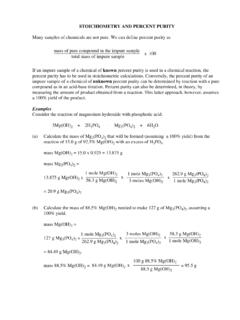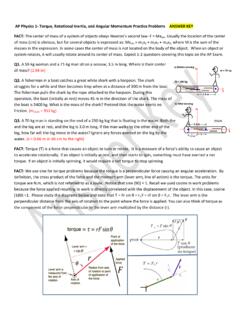Transcription of Physics 1120: Rotational Kinematics Solutions
1 Questions: 1 2 3 4 5 6 7. Physics 1120: Rotational Kinematics Solutions 1. Initially, a ball has an angular velocity of rad/s counterclockwise. Some time later, after rotating through a total angle of radians, the ball has an angular velocity of rad/s clockwise. (a) What is the angular acceleration? What is the average angular velocity? How much time did this take? (b) At some point the angular velocity of the ball had to have been zero. At what angle from it's initial orientation did this occur and how long did it take? A well labeled sketch usually helps make the problem clearer. (a) The object is rotating and we are asked to find kinematic quantities, so this is a Rotational Kinematics problem. 0 = + rad/s f = rad/s = + rad =? average = ? t=? Note that I have taken counterclockwise as the positive direction and that the signs are explicitly stated. It is a very common source of error to leave out or to not consider the signs of directions of all vector quantities.
2 To find the angular acceleration, we find the Kinematics equation that contains and the given quantities. Examining our equations we see that we can use . Rearranging this equation to find yields . Notice that the acceleration is negative. This means that the acceleration points clockwise. It means that an object's rotation will slow, stop, and reverse direction. The average velocity is defined . To find the time, we find the Kinematics equation that contains and t and the given quantities. Examining our equations we see that we can use . Rearranging this equation to find t yields . (b) When a rotating object changes its direction of rotation, we know that the object is instantaneously at rest and that its velocity at that point is 3 = 0. The information that we have is thus: 0 = + rad/s 3 = 0 rad/s (This is our new final angular velocity). = rad/s2. = ? t=? Notice that the angular acceleration is a constant of the motion it has the same value in both parts of the problem.
3 To find the displacement from the initial position where the ball reverses direction, we find the Kinematics equation that contains and the given quantities. Examining our equations we see that we can use . Rearranging this equation to find yields . Notice that this value is bigger than the original rad and is consistent with the sketch, the ball had rotated more when it turned around. To find the time it takes for the ball to reach the point where it turns around, we find the Kinematics equation that contains t and the given quantities. Examining our equations we see that we can use . Rearranging this equation to find t yields . Notice that this value is smaller than the time in part (a) and is consistent with the sketch, the ball hasn't turned back yet. 2. In the diagram below, a rope is threaded around three pulleys of radii, R1 = m, R2 = m, and R3 = m. There is no slippage.
4 (a) If the rope moves with constant speed v = m/s, what is the angular velocity of each pulley? What is the frequency and period of each pulley? (b) The rope accelerates from m/s to m/s in s, what is the average angular velocity of each pulley for this time? What is the average angular acceleration of each pulley? How many revolutions does each pulley turn in that s? The object is rotating and we are asked to find kinematic quantities, so this is a Rotational Kinematics problem. The key physical point is that the speed of the belt and the tangential speeds of each pulley are the same since the belt does not slip, vbelt = v1 = v2 =v3 . Let's assume that the belt moves to the right. Since v = R, n = vbelt/Rn. So we have . Pulley 1 Pulley 2 Pulley 3. 1 = vbelt/R1 2 = vbelt/R2 1 = vbelt/R1. = ( m/s)/( m) = ( m/s)/( m) = ( m/s)/( m). = rad/s = rad/s = rad/s (minus means clockwise).
5 F1 = 1/2 = s 1 f2 = 2/2 = s 1 f3 = 3/2 = s 1. T1 = 1/f1 = s T2 = 1/f2 = s T3 = 1/f3 = s (b) For the increased belt speed, we can again use n = vbelt/Rn to get the new angular velocities of the three pulleys. With an initial and a final angular velocity and an elapsed time, we can find all the desired quantities using our Kinematics equations: average = ( f + 0), = ( f 0)/t, and = averaget. Pulley 1 Pulley 2 Pulley 3. 1i = rad/s 2i = rad/s 1i = rad/s (minus means clockwise). 1f = vbelt/R1 2f = vbelt/R2 1f = vbelt/R3. = ( m/s)/( m) = ( m/s)/( m) = ( m/s)/( m). = rad/s = rad/s = rad/s average 1 = ( 1f + 1i) average 2 = ( 2f + 3i) average 3 = ( 3f + 3i). = rad/s = rad/s = rad/s 1 = ( 1f 1i)/t 2 = ( 2f 2i)/t 3 = ( 3f 3i)/t = rad/s2 = rad/s2 = rad/s2. 1 = average 1 t 2 = average 2 t 3 = average 3 t = 250 rad = 375 rad = 750 rad = rev = rev = 119 rev 3. Two rotating disks, each with a visible dot, are show at the same instant in time in the figure below.
6 The disk on the left has zero initial angular velocity and an angular acceleration of = rad/s2. The disk on the right has a constant angular velocity of = rad/s. When will the two disks have turned through the same total angle? How many revolutions will this have taken for each disk? If the disks had different radii, would there be any change to your answers? Since the disks are rotating and we are asked about kinematic quantities, this is a Rotational Kinematics problems. In particular, since there are two objects, the is a two body or constrained problem. To solve we sketch a graph of the angular displacement versus time. The accelerating disk will have a curved versus t line, while it is a straight line for the other disk. Examining the graph will yield the desired constraints. Inspecting the graph, we find that 1 = 2 (1) and t1 = t2 (2). We are given 0 and for each disk (recall that an object with constant velocity has a zero acceleration).
7 We search for an equation which has the known quantities and the unknown quantities and t. This would be = 0t + t2. Our first constraint becomes 01t1 + 1(t1)2 = 02t2 + 2(t2)2 . We can replace t2 by t1 in the equation above by using our second constraint, 01t1 + 1(t1)2 = 02t1 + 2(t1)2 . Plugging in our given quantities yields: (12 rad/s2)(t1)2 = ( rad/s)t1 . Solving for t1 gives the time it takes for the dots to line up, t1 = t2 = s. Now that we have time, we can find any other quantity. Plugging values into = 0t + t2, yields 1 = 2 = rad. This is how much each disk turns before they once more line up. To find the number of revolutions note that each revolution is 2 rad, so /2 = revolutions. Each disk has turned revolutions. If the two disks had different radii, it would make no difference to our result. We were looking at Rotational quantities, , , and , which are independent of radius.
8 4. A ball is thrown into the air at an angle of 25 to the horizontal with a velocity of m/s. As the ball leave the pitcher's hand it has an angular velocity of rad/s. How many revolutions does the ball make before it returns to the same level? Note that the x, y, and Rotational motions are all completely independent. Also note that the linear velocity given is not the velocity in the equation v = R. This problem is a combination of a Rotational Kinematics problem with a projectile motion problem. In both type one starts by listing the given and requested quantities. i j rotation v0x = m/s cos(25) = m/s v0y = m/s sin(25) = m/s 0 = rad/s ax = 0 ay = g = m/s2 =0. x = 0 y = 0 =? t=? t=? t=? Notice that y = 0, since the ball returns to the same height. Also = 0 as the ball is in the air no force is making it change its rotation. Time is the common factor for this problem. Note that there is enough information in the j column to determine the time in air using y = v0yt gt2.
9 Since y = 0, this reduces to t = 2v0y/g = s. We then find using = 0t + t2. = ( )( ) = rad. To convert from radians to revolutions, recall that 1 revolution = 2 radians. Hence = / 2 = revolutions. The ball rotates times. 5. A motorcycle has tires with a diameter of cm. Cruising down the highway, they are rotating at 1150 rpm (revolutions per minute). What is the angular velocity in radians per second? What is the frequency and period of the tires? What is the tangential velocity of the edges of the tires (and hence the linear velocity of the motorcycle) in m/s and km/h? Converting from rpm to rad/s . The frequency is given by f = /2 = s 1, and the period is given by T = 2 / = s. The physical point here is that the linear speed of the motorcycle is equal to the tangential speed of the motorcycle's wheels, vLinear = vTangential , where vTangential = Rwheel = rad/s m = m/s. The motorcycle's speed is m/s or km/h.
10 6. A bicyclist uniformly increases his pedaling from 30 rev/min to 120 rev/min in s. For that time interval determine: (a) the linear acceleration of the bike, (b) the final linear speed of the bike, and (c) the distance traveled by the bike. As shown in the diagram below, the pedal gear has a radius of cm, the back wheel gear has a radius of cm, and the back wheel itself has a radius of cm. Since we are dealing Rotational variables, this is a Rotational Kinematics problem. The important physical principles at work here are: i. The linear kinematic variables of the bicycle are equal to the tangential kinematic variables of the bicycle's wheels. Thus xlinear = Stangential, vLinear = vTangential, and alinear = atangential. The tangential and Rotational variables for the wheel are related by Stangential = Rwheel wheel, vtangential = Rwheel wheel, and atangential = Rwheel wheel ii.














